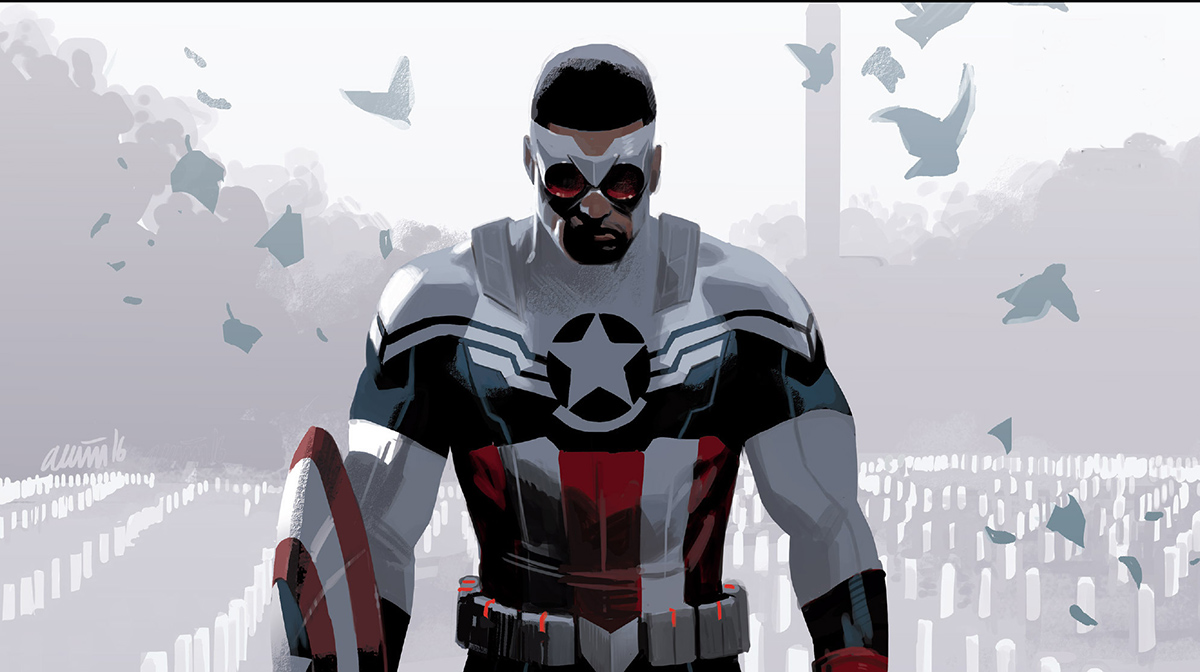For some time now I’ve been itching to write about the Black presence in comic books. Full disclosure, I primarily read mainstream comics, and have for years now. I’m actually being coy. Outside of cinema, my life’s work, comic books and their related characters are my main obsession. I even possess encyclopedic knowledge of comics, second only to, again, cinema and television.
So what finally made me take the time to bring keyboard to computer screen? This issue, in particular these scenes, from Captain America: Sam Wilson #10, chronicling the death of hero James Rhodes, the War Machine in the pages of Marvel’s latest epic Civil War II.
If you’re unaware, Samuel ‘Sam’ Wilson has since 1969 until late 2014 been known as the adventurer the Falcon. Given the ability to communicate with his own falcon Redwing, an ability that has been augmented to visual communication via other birds, he served as the on-again/off-again, and arguably best-friend, to the first Captain America, Steve Rogers, as well as a member of The Avengers. After Rogers lost the super-soldier serum that turned him to the 90 year old man he was supposed to be, he passed on the mantle of Captain America to Sam.

After one and a half years, Rogers was revived of his super-solider serum by an otherworldly character named Kobik (long story!) and is sharing the Captain America moniker with Sam. We’ll see how much longer that lasts. Meanwhile, Sam has encountered a myriad of issues as Cap, most notably his decision to separate from working with the government, mostly the super-spy organization S.H.I.E.L.D. of which he was a longtime agent. This decision came after he found out about unscrupulous activities the agency engaged with. Believing Captain America should be more socially active, Sam was met with severe criticism (though also some support) by the American public, many of whom also dislike that a Black man is, and with the return of Rogers continues to be, Captain America.
That the book’s writer Nick Spencer has made these social and racial dynamics a basis for the series, concurrent with villains consisting primarily of the new corporate-centered Serpent Society in the newest series’ first arc who presents an extreme in social opposition to Sam’s new-ish perspective on crime fighting, is highly significant. But that shines through at its peak with issue #10 in which, to put in deeper perspective, how the ‘family,’ the core of the Black/African diaspora heroes of the Marvel Universe gather together when/if something major, like a death, occurs with one of their own.
What makes this gathering so dynamic is mainly that it just makes perfect sense. Living in an America that constantly fails to acknowledge the foothold of white supremacy in its continuance as a nation, animosity toward these heroes and a lack of acknowledgement of their sacrifice, as the writer acknowledges in Cap’s series almost a full year before the death of fellow Black hero War Machine (who as Rhodes is the best friend to Tony Stark/Iron Man, who built Rhodes’ super armor), is obvious, though barely shown in any of these books.

For the Black Panther, Storm, Luke Cage, Spectrum, Dcotor Voodoo, Misty Knight, Nick Fury Jr (it’s newest member), and Blade (acknowledged in his non-attendance) to gather (as Sam quotes Cage, whose idea this was to occur, “if one of us dies, the rest of us show up together, for the community”) and then host a full memorial – of heroes and the public – makes sense, especially after the senseless death of hero Black Goliath (let’s just acknowledge his horrible moniker and move on from it immediately) during the last event of this nature, Civil War. As does Sam’s eulogy for Rhodey.
Read the book (it’s from almost two months ago now) but his eulogy centers around Rhodey’s constant focus on “the mission,” on doing good and making the world, “a safer, better place,” something many Americans on the front line and behind want, but rhetoric that lately has been confined to certain politicians running for President to euphemistically mean “whiter.” Still, for Sam, Rhodey more than anything was an inspiration to him in showing how to “fill some big shoes” and show that “—maybe I could do that, too,” sentiments that show what being a hero truly means.

That another Black superhero was sacrificed for the sake of a epic comic book storyline, a “good Negro sacrifice,” is not lost on readers. This time around it didn’t feel cheap and manipulative at least since War Machine had an extremely close relationships with Civil War II protagonists Iron Man and Captain Marvel, but the ploy is still suspect.
That shouldn’t stop you however from reading Captain America: Sam Wilson #10, in comic book stores and online now.
What else to read:
In a summer that always provides movie sequels in abundance, there is a comic book series that does the same, but with better success.
Last year writer David F. Walker’s Shaft comic book, exploring the private detective’s life before the movie, burst onto the scene full of all the violence, sex, racial politics you would expect from John Shaft, but told in a more introspective way than any of the three films ever allowed. Complete with covers from comics legend Denys Cowan, the book is now available in trade paperback. Earlier this year the, second miniseries, Shaft: Imitation of Life,was released, and while the story wasn’t as powerful, it did explore the search and pull for fame, and is definitely worth a read. You can find or order the individual issues in your local comics store or online, and I expect it to be collected in trade paperback soon. So check out Shaft and Shaft: Imitation of Life as soon as you can.


